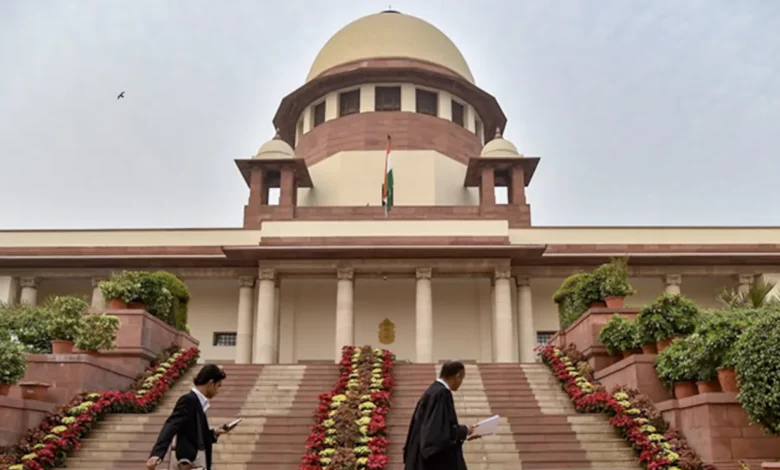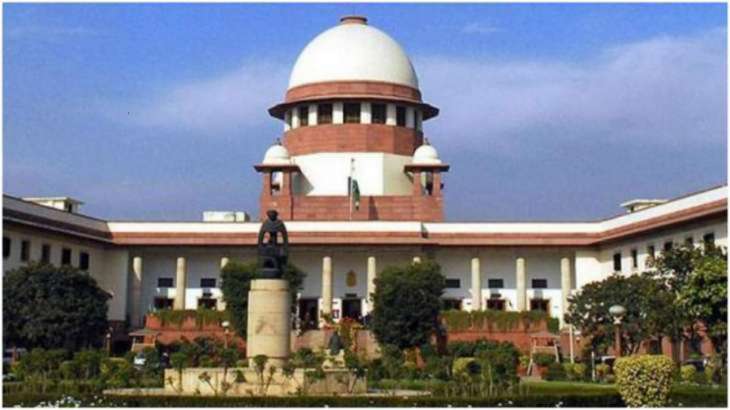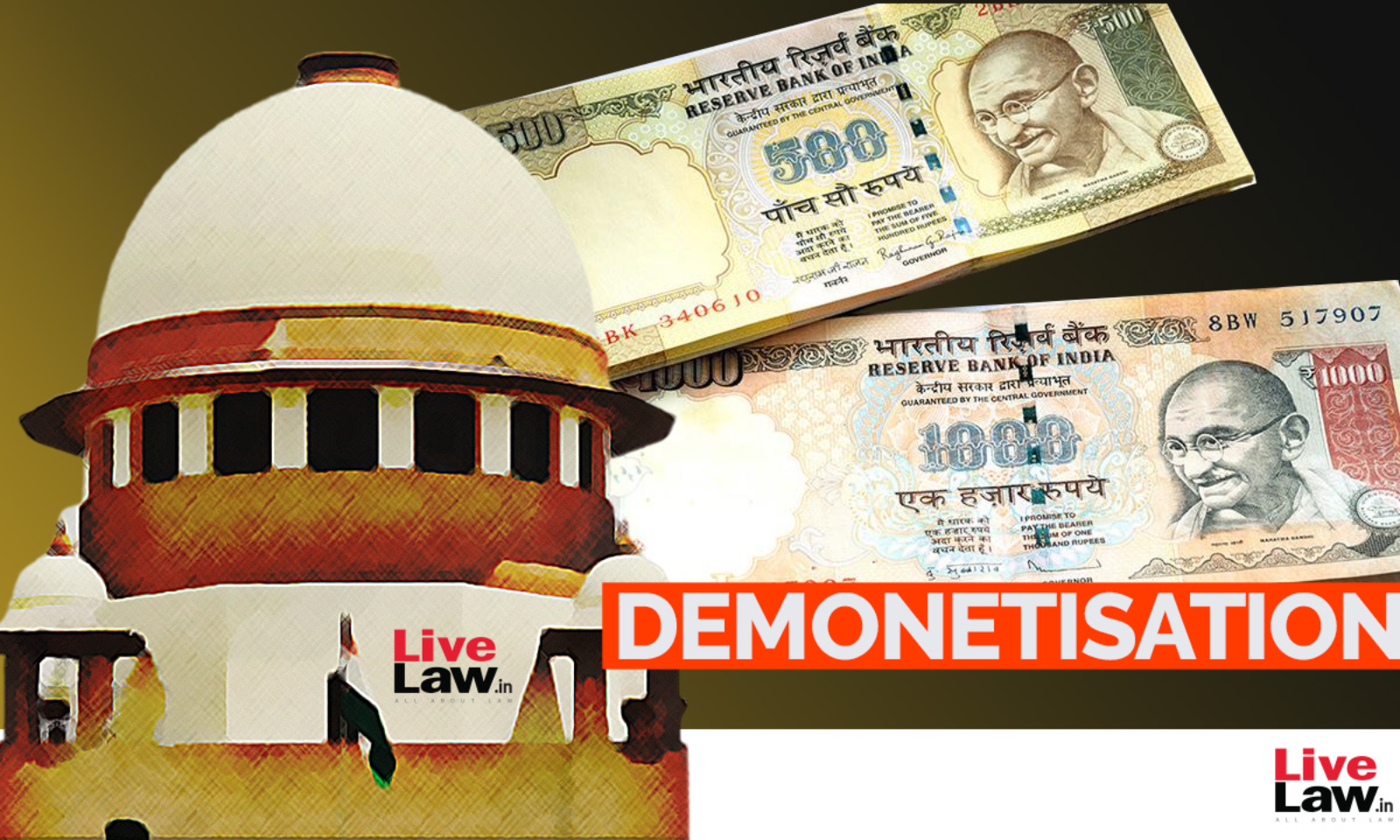What Centre Told Supreme Court On Pleas Challenging Demonetisation?

Supreme Court after hearing extensive arguments over several days on various aspects of the 2016 decision, including the deadline to exchange old currency notes, a five-judge Constitution Bench comprised of Justices S Abdul Nazeer, and B R Gavai, A S Bopanna,and V Ramasubramanian, and B V Nagarathna reserved its order.
The Supreme Court on Wednesday ordered the Centre and also the Reserve Bank of India (RBI) to produce records pertaining to the decision-making process regarding the demonetisation of Rs 500 and also Rs 1000 currency notes in 2016.
After hearing extensive arguments over several days on various aspects of the 2016 decision, including the deadline to exchange old currency notes, a five-judge Constitution Bench comprised of Justices S Abdul Nazeer, B R Gavai, and A S Bopanna, V Ramasubramanian, and also B V Nagarathna reserved its order.
Taking up a batch of 58 petitions challenging the government decision, the bench initially questioned whether it was just an academic debate given the passage of time. However, it later decided to pursue the matter with the petitioners, who claimed that the procedure outlined in Section 26 (2) of the Reserve Bank of India Act, 1934, had been followed.
Senior Advocate appeared on behalf of one of the petitioners.
According to the section, the recommendation should have “emanated” from the RBI, but in this case, the government advised the central bank, which then made the recommendation.
He stated that when the government demonetised currency in the past – in 1946 and 1978 – it did so through a law passed by Parliament.
Chidambaram accused the government of withholding decision-making documents from the court and questioned whether the quorum for the RBI Central Board meeting was met.
Senior Advocate Jaideep Gupta, representing the RBI, stated that “the section does not discuss the process of initiation.” It only states that the process will not be completed unless the final two steps are completed… We made the suggestion.”
“A situation like this can be initiated in many ways, most notably by the Central government,” he said. Terrorism, for example, is a problem about which the RBI is unfamiliar. It is perfectly normal for the Central Government to raise the question, to which the Bank responds with a recommendation.”

Attorney General R Venkataramani stated that demonetisation was not an isolated act, but rather part of a larger economic policy, and thus the RBI or the government cannot act in isolation. “They work together… It is the heart of the entire Act.”
Concerning earlier demonetisation decisions, Gupta stated that the RBI had not agreed to the proposals, as a result of which the government of the day made the law.
He denied withholding any documents from the court. “Nothing is being held back,” Venkataramani added. Nothing is concealed. Of course, if the court requests it, we will provide it.”
The RBI stated in a brief affidavit that the quorum, as defined by the RBI General Regulations, 1949, was met for the Central Board meeting. In addition to the then-Governor and two Deputy Governors, five Directors appointed under the provisions of the RBI Act were present. “As a result, the requirement that three of them be nominated under Sections 8(1)(b) and also 8(1)(c) of the Act is met,” he told the court.
According to Chidambaram, the government cannot demonetise all series of notes of a denomination under Section 26(2). He urged the court to interpret the provision so that the word “any” is read as “some.”
Gupta, on the other hand, argued that such an interpretation would only cause confusion. “Can the government demonetize half, a quarter, or three-quarters of the money?” As a result, this interpretation would only cause confusion,” he explained.
He contended that the petitioners were asking the court to take away the Central Government’s power to withdraw all currency in circulation on the Reserve Bank’s recommendation in a specific case, such as hyperinflation.
“This does not, however, imply that the policy is inherently flawed or that it should be repealed.” In such a case, the action taken under the law, rather than the law itself, can be declared invalid. There is a presumption that, unless proven otherwise, the law is being applied fairly. “It has been held that such decisions cannot be questioned as illegal as long as the trial and error is genuine and with the best intentions,” Venkataramani said.
In response to the Supreme Court’s request to reconsider the 2016 demonetisation exercise, the government stated on Friday that the court cannot rule on a case where no tangible relief can be granted by “turning back the clock” and “unscrambling a scrambled egg.”
The AG’s remarks came after the Supreme Court asked the Union government to explain whether it consulted the Central Board of the Reserve Bank of India (RBI) before scrapping 500 and 1,000 denomination notes in 2016.
The Constitutional Court is hearing 58 petitions challenging the demonetisation process.
In an affidavit filed recently with the Supreme Court, the Centre stated that demonetisation was a “well-considered” decision that was part of a big strategy to combat the severe menace of fake money, terror financing, black money, and also tax evasion.

The Centre had also told the Supreme Court that the decision to currently demonetise currency notes of mainly 500 and 1,000 denominations was made after extensive consultations with the RBI and also that advance preparations were also made before the note ban was enforced.
ARGUMENTS OF PETITIONERS
Former Finance Minister and also senior advocate P Chidambaram slammed the Centre’s 2016 demonetisation policy, telling the Supreme Court that the government’s process was deeply flawed and should be overturned.
Chidambaram claimed that the process was not in accordance with the RBI Act and also made a mockery of the country’s rule of law, calling it the “most outrageous decision-making process.”
P Chidambaram stated that the government’s power to demonetize is based solely on the recommendation of the Central Board, but there was also a reversal of procedure in the current case.
Chidambaram stated that because the currency is the responsibility of the RBI, the process cannot be reversed to the centre advising the RBI, and the RBI submitted to the centre’s advice and issued its recommendation after a one-hour meeting in one day.
The Centre withheld vital documents:
Chidambaram claimed that the Centre was withholding critical decision-making documents, such as the letter from the Government to the RBI dated November 7 and the minutes of the central board meeting.
According to P Chidambaram, the Centre also took the most extreme step without considering any other options for dealing with fake currency and black money, and it also failed to meet its objectives.
While the court may not be able to undo what has been done, Chidambaram told the court that it can hold that the current government’s action was unreasonable and also clarify that such power cannot be exercised otherwise. He went on to say that it would completely destabilise the country.

Demonetisation resulted in the withdrawal of 86.4% of the currency in circulation:
Chidambaram stated that the demonetisation action resulted in the withdrawal of 86.4 percent of currency, and it is a safe bet that this information was not even shared with the RBI board.
He argued that, under the test of proportionality, the alleged RBI recommendation and the impugned government decision deserve to be overturned, because demonetisation, as it was carried out, imposed a disproportionate and intolerable burden on people, resulting in the loss of hundreds of lives and livelihoods of Indian citizens.
Chidambaram contended that in section 26(2), which allows the central bank to demonetize ‘any series’ of notes, any must mean some and not all.
If any is not interpreted to mean’some,’ it is interpreted to confer an absolute power to mainly demonetise any denomination, which would mean all denominations, which is a drastic power and would render the section unconstitutional.
Senior Advocate Shyam Divan stated that people who kept their money in India and did not take it abroad had no recourse. He added that the scheme does not capture or consider the situation of those citizens.
While emphasising that it is not a criticism of the policy, Divan stated that the exercise of such power, if left unchecked and without guidance from the courts, can result in massive human impact, affecting lives and livelihoods.
According to Shyam Divan, the Prime Minister made an important policy announcement that included assurances that people would be given opportunities to exchange demonetised currency, which cannot be ignored.
CENTRAL ARGUMENTS:
The Attorney General of India named R Venkataramani, defended the policy, saying it is incorrect to say demonetisation failed to achieve its goals.
The argument that the note ban failed to achieve its stated goal while causing undue hardships is incorrect, according to the AG. “From a broader perspective of economic and social benefits, demonetisation cannot be said to have failed,” AG said.
According to the Attorney General, demonetisation significantly extricated fake currency from the system, which is important because fake currencies and also black money are “such enemies that cannot be easily identified and aslo wear masks all the time.”
The AG argued that it is a well-established principle that there also must be judicial deterrents in economic policy matters. He stated that the court cannot be asked to rule on the question of inaction or perfection in economic policy and legislation.
AG argued that the demonetisation policy benefited the digital economy by increasing electronic transactions, increasing the value of UPI transactions, and making electronic payment mechanisms viable and cost-effective.
The AG also stated that the negative impact on individuals has ended. There is no ongoing wrong that requires the court’s intervention.
“The proportionality test will not apply.” Larger benefits brought to the economic system on the one hand, and incomparable hardship faced by people on the other,” the AG stated.
According to the AG, people’s hardships cannot be the only relevant factor to consider when there is a larger public interest involved in moving toward a wide range of economic and policy transformations.

RESERVE BANK OF INDIA ARGUMENTS:
Senior Advocate Jaideep Gupta, appearing for the RBI, argued that, contrary to what the petitioners claimed, the RBI Act’s process for making a recommendation to the Centre was followed and the required quorum was met.
Gupta objected to Chidambaram’s claims that regulations requiring a quorum had not been followed and that the government and the RBI had not shared details of the meeting and the quorum.
Gupta informed the Supreme Court that the required quorum was present at the RBI’s Central Board meeting, which decided to recommend the demonetisation of 500 and also 1000 rupee currency notes in 2016.
The bench inquired about the number of members present at the meeting. Gupta contended that by claiming that quorum was not met, Chidambaram was ‘fishing,’ and that the burden of proof was on him.
Gupta stated that the RBI made the recommendation and that the process was followed. Gupta also argued against the petitioners’ claim that the RBI must initiate the demonetisation process under Section 26(2) of the RBI Act.
He stated that the provision makes no mention of initiation, with the RBI’s recommendation serving as the penultimate step and the Centre’s decision serving as the final step.
Concerning claims that the decision was made in two days, Gupta stated that the Central Board had certain information readily available when it already made the recommendation and did not have to start from scratch.
Gupta clarified that the time or speed does not imply that something is wrong. “Confidentiality and speed are required, and demonetisation cannot succeed without them,” he said. Gupta contended that people were given opportunities and that extensive arrangements were made to allow them to exchange their money.
OBSERVATIONS OF THE SUPREME COURT:
The Constitution bench posed important questions to both counsels representing the petitioners, the Centre, and the RBI, and made oral observations.
The bench had inquired about the number of members present at the RBI’s Central Board meeting in 2016 when the decision was made to recommend the demonetisation of 500 and 1000 rupee currency notes.

Justice Gavai had orally requested that counsel for the Reserve Bank of India (RBI) provide information about the quorum.
“How many people were there? “It shouldn’t be difficult to tell us,” he said.
A day later, Senior Advocate Jaideep Gupta informed the court that an affidavit had been filed, indicating that the quorum requirements had been met. He stated that while quorum is four directors, there were more than four present.
Responding to the RBI’s argument that the court would not review an economic policy measure judicially, the bench stated that, while it may not go into the merits of the main decision, the procedure can be examined.
“The court will also not consider the merits of a decision; however, it may consider the manner in which the decision was made.” “The court cannot fold its hands and sit because it is an economic policy,” Justice BV Nagarathna stated.
We can only look at whether or not there was legal compliance, according to Justice Gavai.
While considering individual grievances of people who also missed the deadline for exchanging demonetised currency notes, the bench noted that the RBI has the authority under the Specified Notes Act 2017 to allow such exchange if it is satisfied that the claims are genuine. Furthermore, rejecting legitimate claims would be an arbitrary exercise of power.




